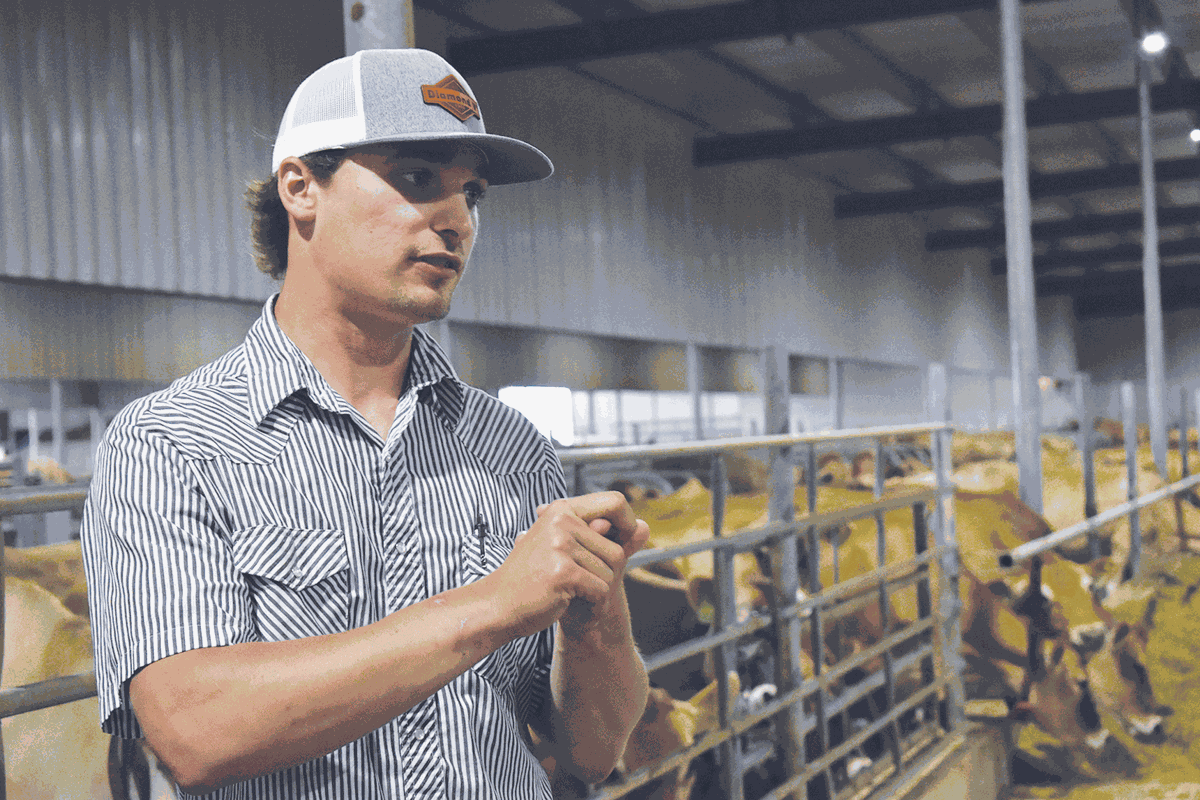
Brent Bosma gave a tour of his family’s dairy, Orland Ridge, during the 2022 South Dakota Governor’s Agricultural Summit. Tri-State Neighbor photo by Melisa Goss
The decision to expand a dairy is never an easy one. As with every sector of agriculture, the dairy industry is constantly riddled with uncertainty.
That’s why it took the Bosma family eight years to finally settle on the right location for their newest dairy operation.
In the end, Madison, South Dakota called their name.
The Bosma family has been milking in Oregon and Washington since the 1970s, however, they’ve been in South Dakota for only the past two years.
The family opened Orland Ridge Dairy near Madison in part because the Agropur processing plant in Lake Norden announced an expansion in 2018 that tripled its production capabilities.
The Bosmas now have a close working relationship with Agropur. During the South Dakota Governor’s Agricultural Summit June 28, while dairy manager Brant Bosma gave one group a tour of the facilities, Deb Wehde, a field representative for Agropur, led another group, proving the company’s dedication to knowing the farmers they work with.
Orland Ridge was just one of several dairies that either expanded or relocated to South Dakota in recent years.
Bob Endres, a dairy inspector with the South Dakota Department of Agriculture and Natural Resources credits the state’s increase in dairies to the availability of feed and clean water, along with the climate.
“Cows like it cold,” he said.
South Dakota is a perfect location for dairies in that regard in the winter months, but with the short summer months producing as much heat and humidity as some southern counterparts, dairies need some reinforcements.
Which is the reason Orland Ridge’s cross-ventilated barn has so many fans.
In the summer, they can have all the fans on and all the curtains open to maintain as much airflow as possible, Bosma said.
In the winter they have as few as eight fans running and close the curtains so the cows generate their own heat in the barn.
The temperature in the barn never drops below 32 degrees, the minimum temperature for the robotic milkers to operate.
Orland Ridge Dairy uses Lely robotic milking machines and other emerging technologies.
The tech is centered primarily on keeping the cows comfortable, though it also increases sustainability.
When cows are comfortable, they produce higher quality milk, a fact Bosma has seen proven true since switching to robotics.
Orland Ridge has 24 Lely Astronaut robotic milkers on 1,600 Jersey cows.
Bosma said the family switched from Holsteins to Jerseys roughly 15 years ago. In part, because the milk they produce is higher in butter fat and protein, but also because the cows have smaller frames and are easier to work with.
Bosma also likes the breed’s gentle disposition.
People are also reading…
“They’re like giant dogs,” he said.
The use of robotics allows the cows to decide for themselves when to eat, drink, relax or be milked. The cows enter the machines totally voluntarily.
Usually, a typical cow will come to the robotic milker three times each day. While she is in the milking machine, feed is rationed 4 ounces at a time. The amount of feed correlates to the quantity of milk the cow produces.
“They don’t come because they feel full, they come because they want feed,” Bosma said.
The dairy is working on an expansion that would double both the number of robots and herd size. However, it will only increase the number of employees by three.
Currently, the farm employs 10 people.
With milking robots, labor needs are significantly lower than on standard dairies.
With so many large machines in the barn, one might think it would be a noisy environment, but it’s actually quiet, which is another bonus of robotic milkers.
Each cow wears a collar that holds data specific to that animal. When the cow enters the robotic milker, the robot scans the collar to determine if she is ready to be milked or not. If not, the gate opens and she returns to the barn.
The collar also monitors things like rumination time, the amount of time the cow spends resting, and overall health.
Once the cow enters the milking stall, the robot uses brushes on a robotic arm to clean the udder. Brush cleaning also stimulates the nerves moving through the spinal cord to the pituitary gland in the cow’s brain. Once clean, a laser scans her udder, assessing the location of each teat. It then attaches a milker to each teat, one by one.
When milking is complete, the teat cups are removed. The claw, each teat cup and the brushes are disinfected between each cow to prohibit cross contamination.
The milking process takes about seven minutes from start to finish.
Because the barn is quieter, the cows can come and go freely and remain with their herd during the milking process, the cows are generally more relaxed than those milked with traditional equipment.
A computer collects data from each milking and can send it to the farmer’s cell phone.
Small samples of milk are also taken each time.
Milkers aren’t the only automated machines at Orland Ridge.
Each alley in the barn has a large green box – an automated manure scraper. It slowly makes its way from one end of the alley to another, scraping manure into pipes just below the barn floor.
The manure flows through the pipes into the on-site manure pit where it’s separated. A pump sends the liquid back to the top to keep things flowing, storing it to be spread on fields later.
Dried manure fiber is moved through a separate pipe and stock piled outside the end of the pit.
The dried fiber is used as bedding for the cattle, though it must be used fairly quickly to avoid rot. It’s another way Orland Ridge Dairy is using a sustainable system, embracing technology and contributing to South Dakota’s growing dairy industry.
Source: agupdate.com










